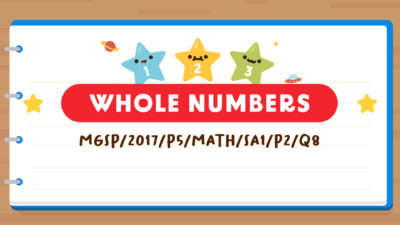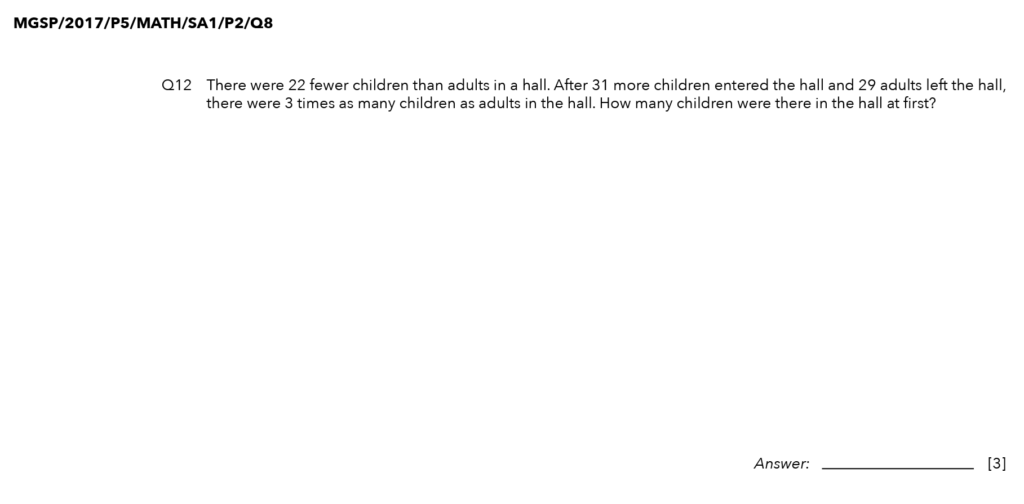Introduction
When faced with P5 Math word problem sums that require you to draw models, it is important that you also add complete labels neatly for ease of reading later.
In this P5 Math blog post, I will be sharing 5 tips on how to draw comparison models to help you solve P5 Math questions faster!
You can also watch my explainer video by clicking this link.
Let’s Take A Look At This Whole Numbers Question
Source: Methodist Girls’ School — 2017 P5 SA1 Examination Paper [Q8]
Read Also:
Let Us Identify The Keywords In The Question
Let us read the first sentence: There were 22 fewer children than adults in a hall.
We are focusing on the keywords “children” and “adults.”
Another keyword that we can see here is “fewer.”
Are there more children or more adults in the hall?
🧐 Remember This When You See The Keyword ‘Fewer’ 🧐
The word “fewer” always goes to the first person or first group of people in the sentence, in this case, it goes to the “children”.
The opposite of fewer is more.
Therefore, there are more adults in the hall!
Let us draw a model to help you visualise the comparison between the children and the adults.
Drawing The Comparison Model
We are going to use the Comparison Model because we are comparing the number of children with the number of adults. Follow these tips to help you draw clear and easy-to-understand models.
Model Drawing Tip # 1️⃣
Stack your models together.
By stacking together our models for the children and adults, they are like cakes that are easy to slice 🍰
You can also use a ruler to draw this neatly.
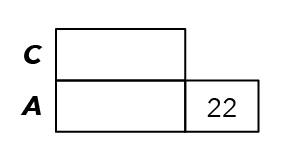
Model Drawing Tip # 2️⃣
Draw your models big and clear.
Make your models easy to read for your teachers!
Let us now go back to the question.
After 31 more children entered the hall and 29 adults left the hall, there were 3 times as many children in the hall.
How can we include this information in our model?
Let’s start by adding 31 more children to our model. But if we were to use a solid line to input this, we may have difficulty identifying this change later on.
Let us use dotted lines to represent this addition. This way, it will be easier to see this change.
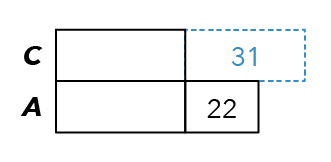
Now that we’re done with the children, let us remove the 29 adults from the model.
To keep our model clear and easy to understand, let us draw two diagonal lines (as shown in blue) at the corner of the model that we want to remove.
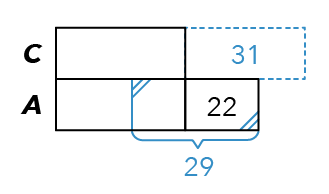
Model Drawing Tip # 3️⃣
Use dotted lines to represent addition or diagonal lines to represent subtraction.
Let us continue reading the question.
There were 3 times as many children as adults in the hall.
Let us convert the number 3 into an improper fraction.

![]()
Model Drawing Tip # 4️⃣
Label model with names, known quantities, and units.
The numerator 3 represents the children, while the denominator 1 represents the adults.
Let us label these units in our model.

Model Drawing Tip # 5️⃣
Use highlighters to show how many adults and children are left in the hall.
To help you easily see how many adults and children are left in the hall, let us use a green highlighter in our model.
Comparing children with adults, we observe a difference of 3 units – 1 unit, which will give us 2 units, composed of 7 and 31.
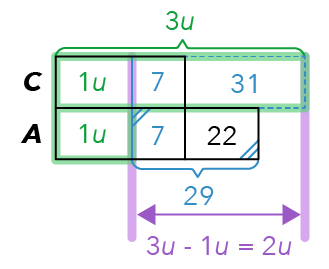
Let us formulate equations to determine the value of 1 unit.
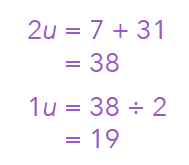
Remember that the question is asking us how many children were in the hall at first.
Where can we find this information in our model?
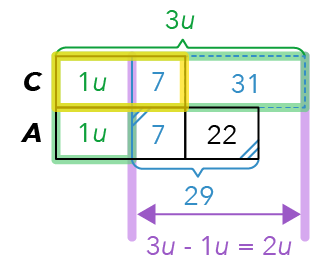
It is the part highlighted in yellow, which excludes the additional 31.
This is why it is important to draw additional values in dotted lines so we can spot them easily.
Therefore, to find the number of children at first, it will be 1 unit + 7, as shown in our model.
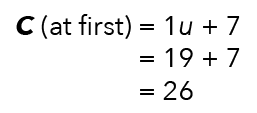
Suggested Answer For Q8
26 children
Conclusion
Remember these 5 tips when drawing comparison models:
1️⃣ Stack your models so that they are like a cake that is easier to slice
2️⃣ Draw your model big and clear enough for your teachers to see 🤓
3️⃣ Use dotted lines, diagonal lines, or other marks to easily differentiate between the original and changed values 📉
4️⃣ Label your model with names, known quantities, and units 🏷
5️⃣ Use a highlighter to help you see the different values clearly 🎨
💡 Remember that you can use the Model Drawing Technique for these P5 Math topics💡
💯 Whole Numbers
🍰 Fractions
🍕 Ratio
📊 Percentage
🔢 Decimals
Stay tuned for more P5 Math model-drawing tips!

If you like our methodology, we've some ongoing weekly Math classes:


